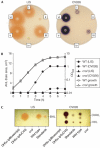Quorum sensing has an unexpected role in virulence in the model pathogen Citrobacter rodentium
- PMID: 17557113
- PMCID: PMC1905894
- DOI: 10.1038/sj.embor.7400984
Quorum sensing has an unexpected role in virulence in the model pathogen Citrobacter rodentium
Abstract
The bacterial mouse pathogen Citrobacter rodentium causes attaching and effacing (AE) lesions in the same manner as pathogenic Escherichia coli, and is an important model for this mode of pathogenesis. Quorum sensing (QS) involves chemical signalling by bacteria to regulate gene expression in response to cell density. E. coli has never been reported to have N-acylhomoserine lactone (AHL) QS, but it does utilize luxS-dependent signalling. We found production of AHL QS signalling molecules by an AE pathogen, C. rodentium. AHL QS is directed by the croIR locus and a croI mutant is affected in its surface attachment, although not in Type III secretion. AHL QS has an important role in virulence in the mouse as, unexpectedly, the QS mutant is hypervirulent; by contrast, we detected no impact of luxS inactivation. Further study of QS in Citrobacter should provide new insights into AE pathogenesis. As the croIR locus might have been horizontally acquired, AHL QS might exist in some strains of pathogenic E. coli.
Figures




References
-
- Ahmer BM (2004) Cell-to-cell signalling in Escherichia coli and Salmonella enterica. Mol Microbiol 52: 933–945 - PubMed
-
- Coulthurst SJ, Williamson NR, Harris AK, Spring DR, Salmond GP (2006) Metabolic and regulatory engineering of Serratia marcescens: mimicking phage-mediated horizontal acquisition of antibiotic biosynthesis and quorum-sensing capacities. Microbiology 152: 1899–1911 - PubMed
Publication types
MeSH terms
Substances
Grants and funding
LinkOut - more resources
Full Text Sources
Research Materials

